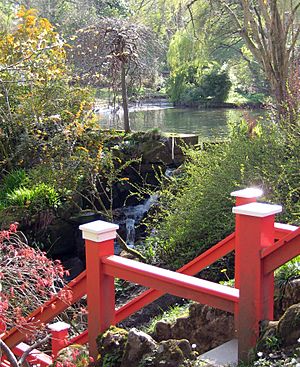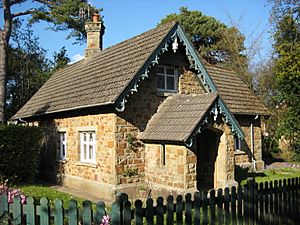Clyne Gardens facts for kids
Clyne Gardens is a beautiful botanical garden located in Swansea, Wales, UK. It's a fantastic place to explore nature! The park you see today started as the amazing gardens of Clyne Castle. These gardens were first created by Glynn Vivian, who bought the castle in 1860.
Later, in 1921, the estate went to his nephew, Algernon. People called him 'The Admiral'. He owned the gardens until 1952 and made the biggest changes, shaping them into what we enjoy today. Clyne Gardens is found between Mumbles Road and Mayals Road in the Blackpill and Mayals areas of Swansea. You can enter from both roads.
Contents
What to See and Do
The gardens cover about 19 hectares of land. That's like 19 football fields! They are home to over 2,000 different types of plants. You'll find more than 800 kinds of rhododendrons here, which the gardens are famous for. Clyne Gardens also has special collections of plants like Pieris and Enkianthus. Because the weather here is cool, wet, and mild, many plants that usually don't grow well in this part of the world actually thrive here!
Bog Gardens and Giant Plants
The gardens have large boggy areas. These are wet, marshy spots where you can see giant plants like the Elephant Rhubarb (Gunnera manicata) and American skunk cabbage. They look really impressive!
The Gazebo and Views
Near the castle, there's a lovely gazebo. The Admiral built it so he could watch ships sailing into Swansea Bay. This gazebo is surrounded by tall Monterey Pine trees. Their lower branches help protect the area from strong winds.
The Japanese Garden
At the top of the gardens, you'll find a peaceful Japanese garden. It has a pretty red and white bridge and lots of bamboo plants. There's also an artificial lake with a waterfall that flows under the bridge. The water in this lake comes from Clyne Common and travels through the gardens before reaching the sea at Blackpill. Next to the bridge, look for a special tree called the Handkerchief Tree (Davidia Involucrata var. vilmoriniana).
Other Interesting Spots
You might notice small dog graves scattered around the park. These are memorials to the Admiral's family pets. Near the seafront entrance, there's a tiny building called Joy Cottage. It was built as a miniature house for the Admiral's daughters. Nannies used to teach them reading, writing, and cooking there.
Clyne Chapel
Clyne Chapel was built by William Graham Vivian and opened in 1908. It's a quiet place of worship. Below the chapel, in a private vault, Graham Vivian, his sister Dulcie, and 'The Admiral' are buried.
Amazing Trees
Clyne Gardens is home to some truly remarkable trees.
Tallest Magnolia
You can find the tallest recorded Magnolia tree in Britain here. It's a type called 'Magnolia campbellii var. alba'. Imagine how tall that must be!
Ancient Oak Woodland
There's also an Oak woodland which is a small part of what used to be Clyne Forest. This forest was an important historical landmark way back in the 11th century, during the Norman times.
Glynn Vivian's Plantings
Glynn Vivian, who first bought the castle, planted three special trees in front of it that are still alive today. One is a giant Wellingtonia (Sequoiadendron giganteum). The other two are Monterey Cypress trees (Cupressus macrocarpa). One of these is a very tall, narrow type, and it's also one of the tallest recorded in Britain!



